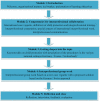Protecting children across borders - child protection in an international context (Germany/Switzerland) as an interprofessional teaching unit
- PMID: 32270018
- PMCID: PMC7105767
- DOI: 10.3205/zma001297
Protecting children across borders - child protection in an international context (Germany/Switzerland) as an interprofessional teaching unit
Abstract
Introduction: Interprofessional collaboration (IPC) in everyday clinical practice is a prerequisite for good patient care but currently this is not sufficiently anchored in the education of health care professionals. Project description: A course on child protection in the interprofessional and international domain was established at the Medical School, University of Freiburg. In this course, students of medicine, nursing science and social work acquire skills for successful interprofessional cooperation. Its participants learn across professional and national borders, not only with but also from and about each other. In this way, they deepen their insights into international IPC through a key topic that is relevant to many disciplines. The course is run as a one-day campus day. This paper presents the course setup and evaluation results. Methods: The evaluation was carried out online and in writing in a before and after format using the Freiburg Questionnaire for Interprofessional Learning Evaluation (FILE) in addition to oral feedback. Learning objectives for IPC and child protection were formulated and the participants were asked about their subjective achievements. Results: From summer semester (SuSe) 2017 to SuSe 2018, 39 participants took part in the course. It was rated as m=1.5 (using German school grades where 1=very good, 6=unsatisfactory). In 18 of the 26 FILE items, participants report a self-assessed increase in knowledge or skills/abilities. This growth in learning coincides with the learning objectives set. Discussion & conclusion: From the perspective of the participants, the course teaches interprofessional competencies in an international setting and is seen as an informative course offer. The continuation or expansion of such courses as a supplement to purely single-country interprofessional courses is desirable.
Einleitung: Interprofessionelle Zusammenarbeit (Interprofessional Collaboration, IPC) im klinischen Alltag ist Voraussetzung für eine gute PatientInnenversorgung, bisher bereitet die Ausbildung in Gesundheitsberufen darauf aber zu wenig vor.Projektbeschreibung: In Freiburg i. Br. wurde eine Lehrveranstaltung (LV) zum Kinderschutz im interprofessionellen und internationalen Umfeld etabliert. Dort erwerben Studierende der Medizin, Pflegewissenschaft und Sozialen Arbeit gemeinsam Kompetenzen für eine erfolgreiche interprofessionelle (IP) Zusammenarbeit. Dabei lernen die Teilnehmenden (TN) grenzüberschreitend nicht nur mit-, sondern auch von- und übereinander. Sie vertiefen so den bedeutenden Aspekt der internationalen IPC beispielhaft an einem für viele Fachrichtungen relevanten Thema. Die LV findet als eintägiger Campustag statt. Diese Arbeit stellt den Ablauf der Lehrveranstaltung und Evaluationsergebnisse vor.Methoden: Evaluiert wurde online und schriftlich in einem prä-post-Format mit dem Freiburg Questionnaire for Interprofessional Learning Evaluation (FILE), zudem erfolgt ein mündliches Feedback. Lernziele zur IPC und zum Kinderschutz wurden formuliert und die TN zu deren subjektiven Erreichen befragt.Ergebnisse: Von Sommersemester (SoSe) 2017 bis SoSe 2018 nahmen 39 TN an der LV teil. Sie wurde mit m=1,5 (deutsche Schulnoten) bewertet. In 18/26 Items des FILE berichten die TN von einer selbsteingeschätzten Zunahme von Wissen oder Fertig-/Fähigkeiten. Dieser Lernzuwachs deckt sich mit den gesetzten Lernzielen.Diskussion & Schlussfolgerung: Aus Sicht der TN vermittelt die LV IP Kompetenzen im internationalen Setting wird als lehrreiches Angebot wahrgenommen. Die Weiterführung bzw. ein Ausbau solcher LV als Ergänzung zu mononationalen IP LV ist wünschenswert.
Keywords: IPC; IPE; child protection; course; internationality; interprofessionalism; pediatrics.
Copyright © 2020 Krampe et al.
Conflict of interest statement
The authors declare that they have no conflicts of interest in connection with this article. The project is part of the “LongStI” of the University of Freiburg, which is part of the project “MERLIN – Teaching Research in the Baden-Wuerttemberg Network” of the Federal Ministry of Education and Research. The course was awarded the EUCOR – The European Campus label, which made it possible for students from Switzerland to be awarded travel expenses.
Figures









References
-
- World Health Organization. Framework for action on interprofessional education and collaborative practice. Geneva: World Health Organization; 2010. - PubMed
-
- Barr H, Koppel I, Reeves S, Hammick M, Freeth D, editors. Effective interprofessional education: Argument, assumption and evidence. Hoboken: John Wiley & Sons; 2005. - DOI
-
- Barr H, Ford J, Gray R, Helme M, Hutchings M, Low H, Machin A, Reeves S, editors. Interprofessional Education Guidelines. Fareham: CAIPE; 2017. Available from: https://www.caipe.org/resources/publications/caipe-publications/caipe-20....
MeSH terms
LinkOut - more resources
Full Text Sources

